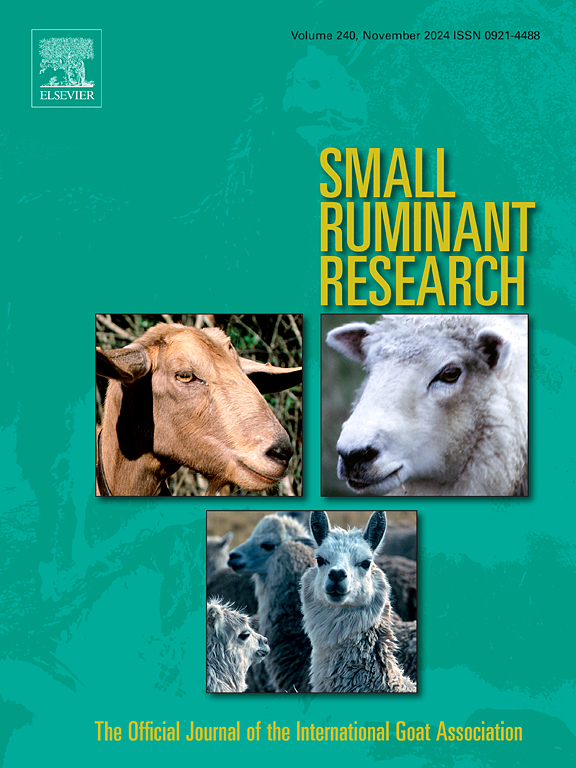Impact of day length on orexin A levels in blood, cerebrospinal fluid and various brain tissues in seasonally breeding sheep
IF 1.6
3区 农林科学
Q2 AGRICULTURE, DAIRY & ANIMAL SCIENCE
引用次数: 0
Abstract
Orexin A (OXA) is a key regulator of the sleep-wake cycle and energy homeostasis in mammals. In rodents, OXA synthesis follows a circadian rhythm positively associated with wakefulness. While similar research is lacking in seasonal animals, we previously demonstrated that OXA mediates photoperiodic effects on reproduction and metabolism in seasonally breeding sheep. This study investigated whether circadian and seasonal rhythms in OXA secretion occur in sheep and how they correspond to tissue-specific concentrations under different photoperiods. Ten adult ewes were kept under natural conditions during long-day (LD; May, nonbreeding season; ∼16 h daylight; n = 5) and short-day (SD; November, breeding season; ∼9 h daylight; n = 5) periods. The experiments were conducted separately for each season to distinguish photoperiodic effects. Plasma was collected over 24 hours; cerebrospinal fluid (CSF) and brain tissues including the choroid plexus (CP), pineal gland (PG), pituitary gland (PTG), and CA1 region of the hippocampus were collected at midday, when OXA peaks in diurnal species. OXA levels were significantly higher (P < 0.01) in LD compared to SD in the CP (95.83 %), CSF (140.00 %), CA1 (66.70 %), and plasma (38.46 %). Plasma OXA displayed circadian variation in both seasons; daytime levels were 41.38 % higher during SD (P < 0.01) and 17.28 % higher in LD (P > 0.05). No seasonal differences were found in PTG or PG. This study may reveal the role of OXA in mediating or modifying the effects of day length on seasonal physiological processes in sheep. For example, elevated OXA in spring and summer, when forage is abundant, may support energy demands for lactation and reserve accumulation in preparation for winter forage scarcity.
日长对季节性繁殖绵羊血液、脑脊液和脑组织中食欲素A水平的影响
食欲素A (OXA)是哺乳动物睡眠-觉醒周期和能量稳态的关键调节因子。在啮齿动物中,OXA的合成遵循与清醒呈正相关的昼夜节律。虽然在季节性动物中缺乏类似的研究,但我们之前证明了OXA对季节性繁殖绵羊的繁殖和代谢有光周期影响。本研究探讨了绵羊体内OXA分泌是否存在昼夜节律和季节节律,以及它们在不同光周期下如何与组织特异性浓度相对应。在自然条件下饲养10只成年母羊;5月,非繁殖期;16∼ h日光;n = 5)和短日(SD;11月,繁殖期;∼9 h日光;n = 5)时期。每个季节分别进行实验,以区分光周期效应。血浆收集时间超过24 小时;中午采集脑脊液(CSF)和脑组织,包括脉络膜丛(CP)、松果体(PG)、脑垂体(PTG)和海马CA1区,此时昼夜活动的动物OXA达到峰值。LD中OXA水平显著高于CP(95.83 %)、CSF(140.00 %)、CA1(66.70 %)和血浆(38.46 %)中的SD (P <; 0.01)。血浆OXA在两个季节均呈现昼夜变化;日间水平在SD期间高41.38 % (P <; 0.01),在LD期间高17.28 % (P >; 0.05)。该研究可能揭示了OXA在调节或调节日长对绵羊季节性生理过程的影响中的作用。例如,草料丰富的春夏两季,OXA升高可能支持哺乳的能量需求,并为冬季草料短缺做准备。
本文章由计算机程序翻译,如有差异,请以英文原文为准。
求助全文
约1分钟内获得全文
求助全文
来源期刊

Small Ruminant Research
农林科学-奶制品与动物科学
CiteScore
3.10
自引率
11.10%
发文量
210
审稿时长
12.5 weeks
期刊介绍:
Small Ruminant Research publishes original, basic and applied research articles, technical notes, and review articles on research relating to goats, sheep, deer, the New World camelids llama, alpaca, vicuna and guanaco, and the Old World camels.
Topics covered include nutrition, physiology, anatomy, genetics, microbiology, ethology, product technology, socio-economics, management, sustainability and environment, veterinary medicine and husbandry engineering.
 求助内容:
求助内容: 应助结果提醒方式:
应助结果提醒方式:


